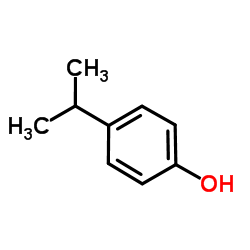Alkylphenol biotransformations catalyzed by 4-ethylphenol methylenehydroxylase.
David J Hopper, Lisa Cottrell
Index: Appl. Environ. Microbiol. 69(6) , 3650-2, (2003)
Full Text: HTML
Abstract
4-ethylphenol methylenehydroxylase from Pseudomonas putida JD1 acts by dehydrogenation of its substrate to give a quinone methide, which is then hydrated to an alcohol. It was shown to be active with a range of 4-alkylphenols as substrates. 4-n-propylphenol, 4-n-butylphenol, chavicol, and 4-hydroxydiphenylmethane were hydroxylated on the methylene group next to the benzene ring and produced the corresponding chiral alcohol as the major product. The alcohols 1-(4'-hydroxyphenyl)propanol and 1-(4'-hydroxyphenyl)-2-propen-1-ol, produced by the biotransformation of 4-n-propylphenol and chavicol, respectively, were shown to be R(+) enantiomers. 5-Indanol, 6-hydroxytetralin, 4-isopropylphenol, and cyclohexylphenol, with cyclic or branched alkyl groups, gave the corresponding vinyl compounds as their major products.
Related Compounds
| Structure | Name/CAS No. | Molecular Formula | Articles |
|---|---|---|---|
 |
p-Cumenol
CAS:99-89-8 |
C9H12O |
|
Convenient QSAR model for predicting the complexation of str...
2009-01-01 [Bioorg. Med. Chem. 17 , 896-904, (2009)] |
|
[Substance toxicity and danger].
1981-01-01 [Gig. Sanit. (1) , 94, (1981)] |
|
Isolation of Insecticidal Constituent from Ruta graveolens a...
2015-08-01 [J. Food Prot. 78 , 1536-40, (2015)] |
|
Removal of BPA model compounds and related substances by mea...
2012-01-01 [J. Environ. Sci. Health. A. Tox. Hazard. Subst. Environ. Eng. 47(14) , 2198-204, (2012)] |
|
Modeling of ultrasonic degradation of non-volatile organic c...
2010-01-01 [Ultrason. Sonochem. 17(5) , 773-82, (2010)] |